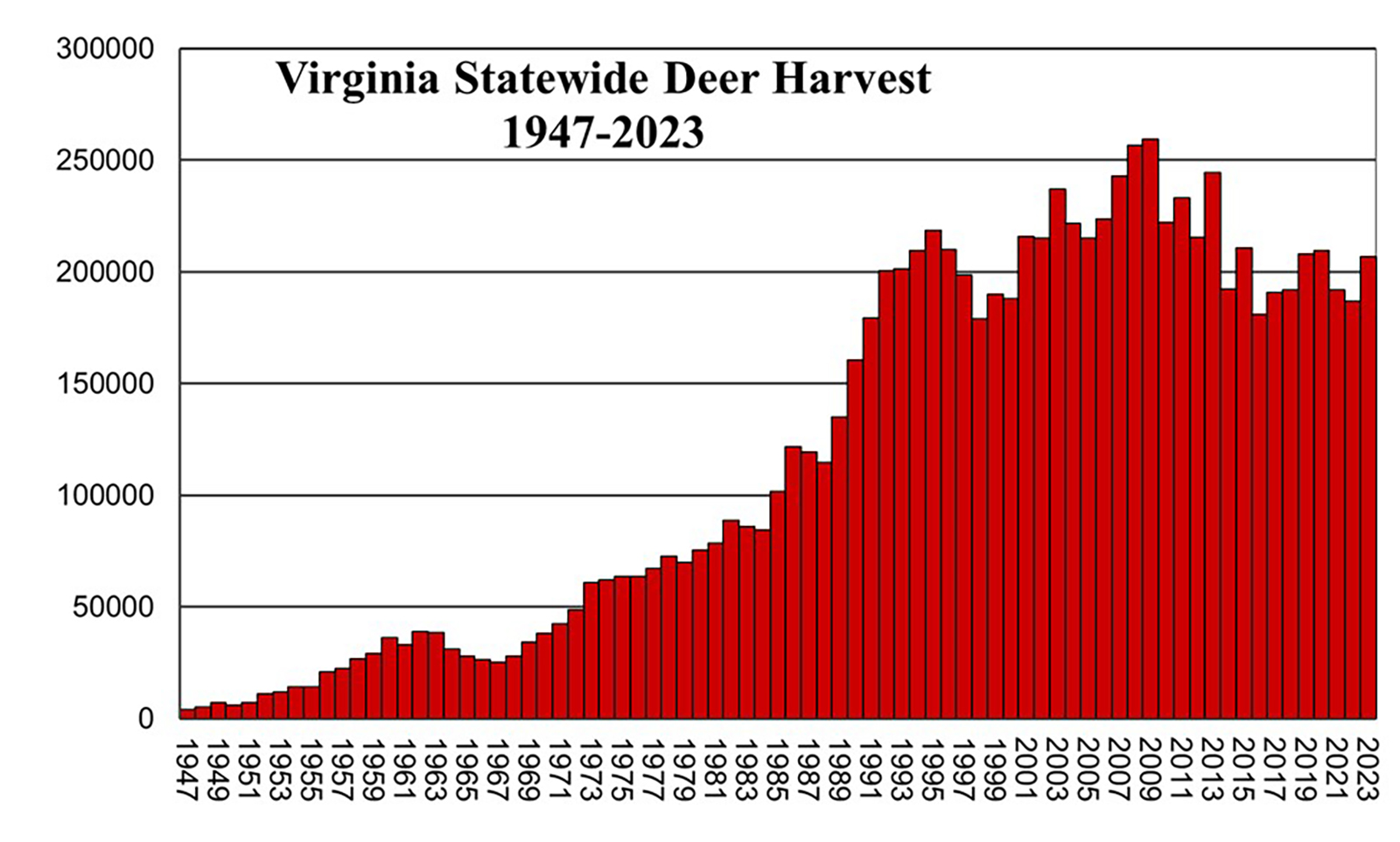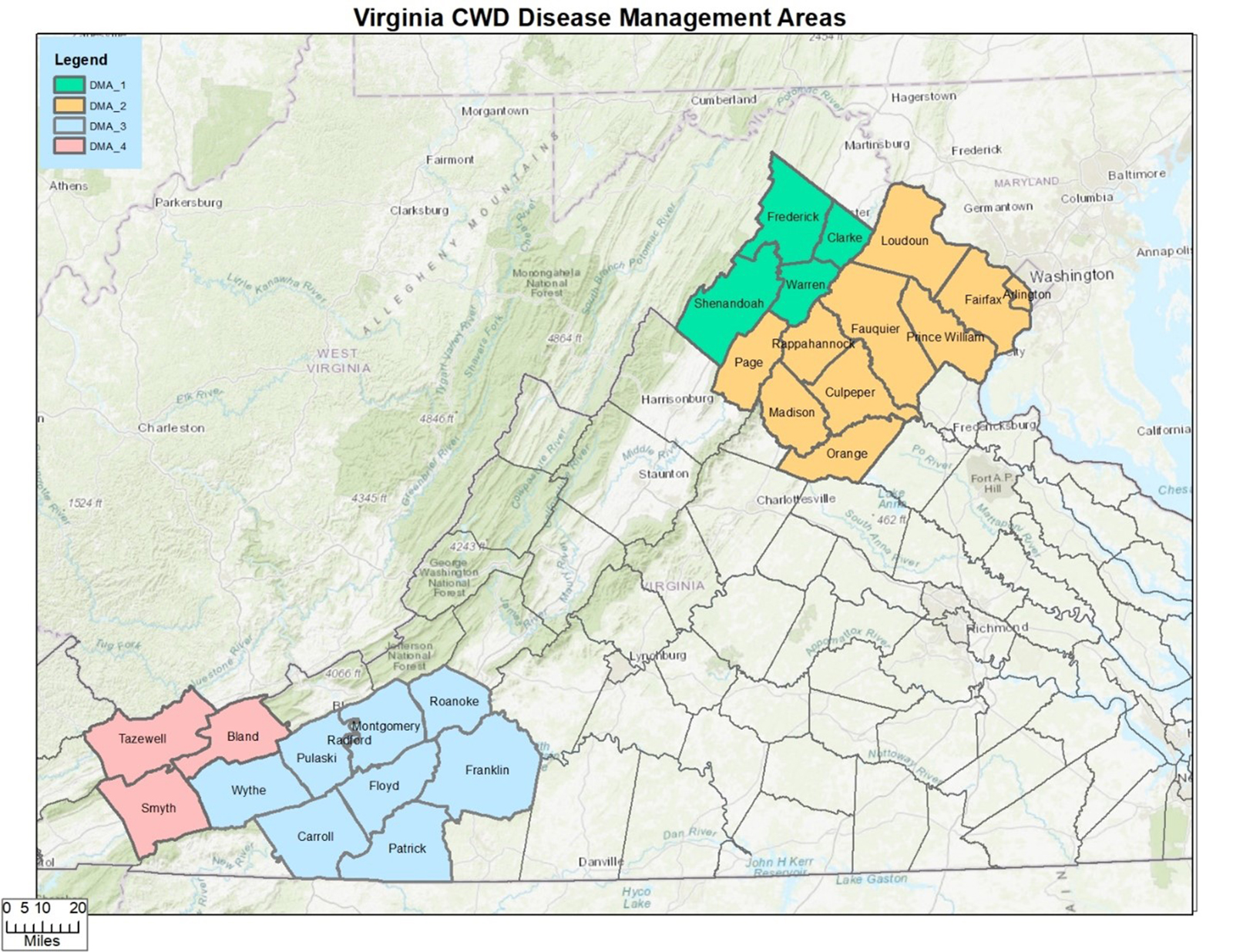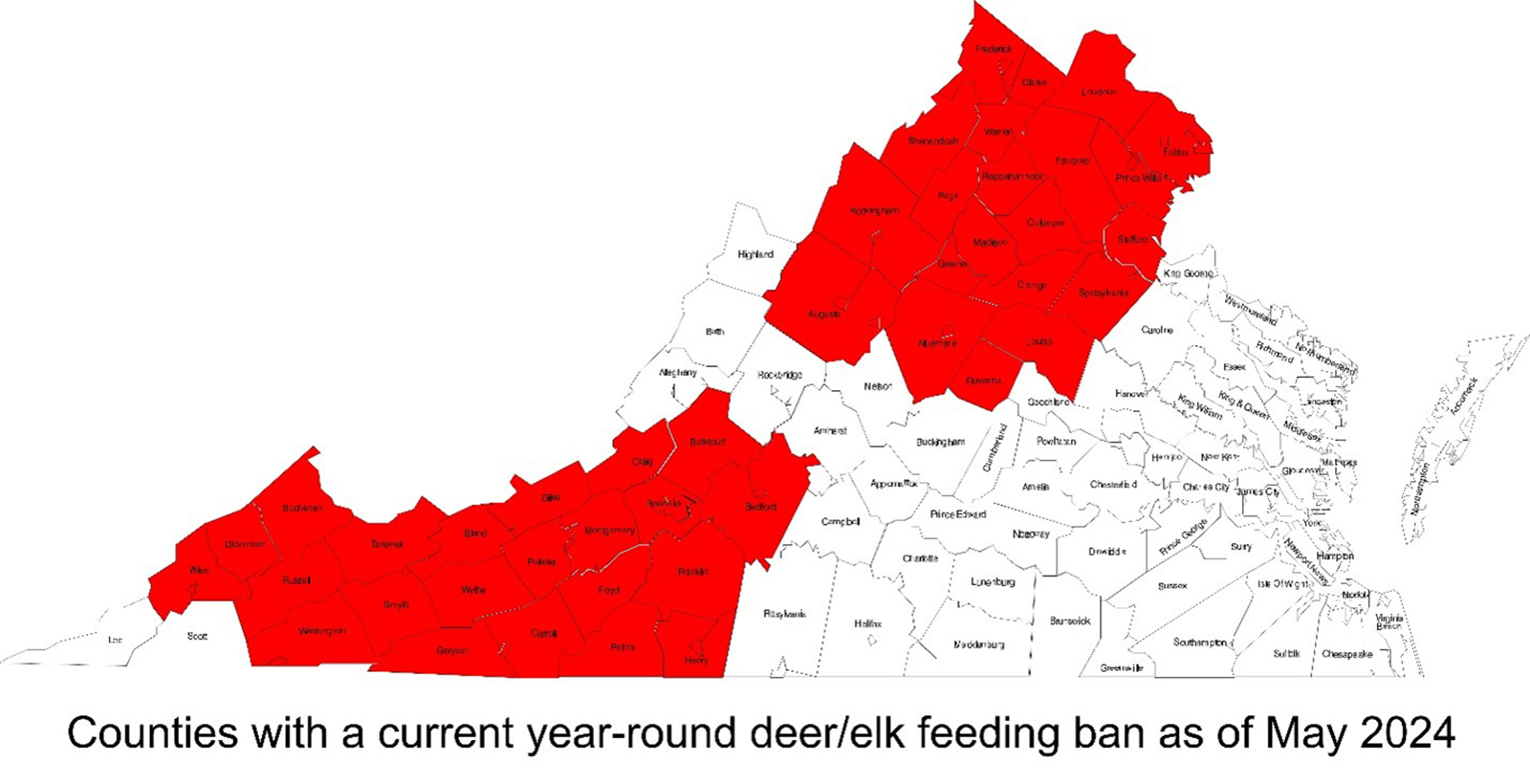By Justin Folks/DWR
2023-2024 Virginia Deer Season Review
During the past deer season (including the early September antlerless seasons), 206,586 deer were reported harvested by deer hunters in Virginia.

Statewide deer harvest totals from 1947-2023.
This total included 105,201 antlered bucks, 982 shed bucks, 12,567 button bucks, and 87,836 does (42.5% females). Archery (including crossbows) accounted for 14% of the deer kill; muzzleloaders, 26%; and firearms, 60%. The youth and apprentice weekend resulted in the harvest of 2,890 deer. When and where deer hunting with dogs is legal, deer taken with the use of dogs made up 50% of the total harvest. The numbers above do not include deer taken on out-of-season deer kill permits or those deer hit and killed by vehicles.
Deer hunters who would like to know the annual deer kill totals by county dating back to 1947, including the county 2023 totals, can find them on the Department’s website.
The 2023-2024 deer harvest was up 5% from the last 10-year average of 196,862. Harvest during the 2022-23 season was down 3% from the previous season, likely due to a bumper crop of acorns. This dip in harvest likely created a “stockpile” of deer for hunters in the 23-24 season. Additionally, deer experienced a mild winter at the end of 2022, entered 2023 on a higher nutritional plane, and were more productive. A number of new deer hunting regulations went into effect, which also may have resulted in increased harvest.
The special late seasons contributed an additional 1,945 antlerless deer to the harvest total, bringing our final tally to 208,531 and 42.8% females harvested.
Chronic Wasting Disease (CWD)
The 2023-24 deer season was a busy one for CWD in Virginia. We had the most positives this past year than any other year since our surveillance began. This past year, we sampled just under 8,000 deer and detected 71 positives, 40 of which came from Frederick County alone. A new detection in Tazewell County was a bit disheartening and will prompt some changes moving forward. Before getting into our DMA summaries, I want to stress the importance of our CWD mandatory sampling days. A key to CWD management is early detection and swift response. We pick the counties for mandatory sampling for a reason—to better estimate the prevalence of CWD in that county as early as feasible.
It doesn’t take long to get a deer sampled, and it’s important for DWR staff to interact with hunters. It definitely has the vibe of the old physical check stations. Also, on a personal level, there’s nothing worse than having to work on the opening day of rifle season at a check station and then hardly anyone shows up. If you’re in a county with a mandatory day, come hang out with us and get your deer sampled.

Map of 2024 CWD Disease Management Areas (DMAs), including the new DMA4.
DMA1 (Clarke, Frederick, Shenandoah, and Warren counties)
There are no changes to the boundaries of DMA1 for the 2024 season. Since July 2023, a total of 685 samples were collected within DMA1, which resulted in 54 positive detections. Frederick County unsurprisingly had the most detections (40), while Shenandoah (six), Warren (two), and Clarke (six) each had at least one detection in 2023.
DMA2 (Arlington, Culpeper, Fairfax, Fauquier, Loudoun, Madison, Orange, Page, Prince William, and Rappahannock counties)
There are no changes to the boundaries of DMA2 for the 2024 season. Since July 2023, 3160 deer were sampled for CWD in DMA2 with nine positive detections: two each in Culpeper, Fauquier, Loudoun, and Rappahannock, and one positive in Madison County. CWD has not been found in Orange or Page counties yet, but it is likely just a matter of time. No new positives were detected in Fairfax this past season, which is good news.
DMA3 (Carroll, Floyd, Franklin, Montgomery, Patrick, Pulaski, Roanoke, and Wythe counties)
DMA3 will now include the counties of Franklin, Roanoke and Wythe due to the locations of positives detected in Carroll, Floyd, and Montgomery. During the 2023 season a total of 1,449 samples were taken within DMA3. This sampling effort yielded positive detections in Floyd (four), Montgomery (two), and the first detection in Carroll (one).
Establishment of DMA4 (Bland, Smyth, and Tazewell)
Our highly successful statewide CWD surveillance efforts through cooperating taxidermists led to the detection of a CWD-positive buck in Tazewell County during the 2023 season. Due to its location, we’ve created DMA4, which will include Bland, Smyth, and Tazewell Counties. High-risk deer carcass parts (brain and spinal cord) must stay in DMA4 or may go into DMA3, but high-risk parts may not be transported from DMA3 to DMA4. CWD is considered “established” in DMA3 and we want to prevent that from occurring in DMA4.
The rest of the state
In addition to the four DMAs noted above, the Department continues to conduct annual statewide CWD surveillance outside of the DMAs using a taxidermist-supported CWD surveillance strategy. Adult males are the sex and age class most likely to have CWD, so working with cooperating taxidermists has been an efficient CWD surveillance method utilized by Virginia and several other states. In fall 2023, 2,647 deer were tested statewide, predominantly via cooperating taxidermists, with several samples coming from clinical suspects and voluntary hunter submissions at regional drop-off sites.
Hemorrhagic Disease (HD)
2023 was an odd year for HD. Things were eerily quiet all summer, and then HD suspect reports blew up at the beginning of October. We usually start getting credible reports toward the end of August. Reports were sporadic statewide, except for a seemingly significant outbreak of HD centered around northeastern Augusta and southeastern Rockingham Counties (Bridgewater and Mt. Crawford area). We collected a handful of viable samples and sent them to the Southeast Cooperative Wildlife Disease Study (SCWDS) lab, where it was confirmed that EHDV-2 virus, the most common epizootic hemorrhagic disease virus strain, was the culprit.
The Shenandoah Valley experienced a very wet spring in 2023 that carried into early summer, but it got hot and very dry in August and September. As we’ve seen historically in Virginia, HD activity is correlated to wet springs followed by hot, dry summers that create ideal breeding conditions (mud flats) for Culicoides midges that carry the HD viruses. The prolonged wet period and late drought conditions are probably what pushed back the start of “HD Season” for us last year. Despite receiving reports of well over 100 deer being found deceased in those two counties (and I’m sure many more were not reported), deer harvest numbers at the county level were similar to or greater than those for the same counties the previous year.
HD activity is rarer west of the Blue Ridge and typically has a greater impact to deer herds there, which leaves me scratching my head. Nationwide, however, deer managers are seeing an increase in HD activity northward and westward, presumably due to changes in climate conditions. If that trend continues, we may be seeing more HD activity west of the Blue Ridge in the future.
The good news is that decades of experience with HD in Virginia clearly shows that, in the absence of any further significant HD activity, deer herds typically recover in a couple of years, even west of the Blue Ridge. HD occurs in Virginia every fall at some low level with occasional severe outbreaks at the local level.
New For Fall 2024
Deer regulations in Virginia are evaluated and amended on a biennial basis. Last year was a “reg year” with many new changes. This coming season will largely follow last year’s regulations, but a few changes will be in place with the establishment of DMA4.
• DMA4 will consist of Bland, Smyth, and Tazewell Counties. Carcass transport restrictions will be in place here for the 2024 deer season. High-risk carcass parts (head, brain, and spinal cord) may not leave DMA4 except to enter DMA3.
• Per State Administrative Code 4VAC15-40-285, a year-round deer feeding ban is now in effect for Bedford, Botetourt, Henry, Russell, Smyth, and Washington Counties (see Figure 3 for a current map of all VA counties with a year-round deer feeding ban)
• Mandatory CWD Sampling Day will be on November 16, 2024 in Carroll, Franklin, Patrick, Pulaski, Shenandoah, Tazewell, and Wythe Counties.

Map of counties with a current year-round ban on the feeding of deer and elk (red). Feeding of deer is prohibited in any county within 25 miles of a CWD-positive detection in addition to the Elk Restoration Zone in Southwest Virginia (Buchanan, Dickenson, and Wise).
Tidewater Forecast
Over most of the past three decades, the deer kill in Tidewater has been fairly stable between 40,000 and 50,000 deer. The one exception was a period between about 2005 and 2013 when DWR hit the deer herds hard on private lands over much of the Tidewater region with liberal seasons and regulations. Because of this liberalization, the deer kill increased to between 50,000 and 65,000 annually and these regulations combined with three HD events in 2012, 2014 (big) and 2016 resulted in a decline in the Tidewater deer herd.
Since that time, regulations have been made more conservative in some areas, and deer herds and deer kill numbers across most of the Tidewater region have recovered. If HD is not a big player in fall 2024, stable deer herds are expected across most of the Tidewater Region. Continued high human population growth rates, crop damage, and deer-vehicle collisions remain important deer management issues in Tidewater. As shown on the map below, most counties in Tidewater are meeting their current population objective as laid out in the current Deer Management Plan. There is not a deer management unit in Tidewater, where DWR is trying to increase the deer population.
Southern Piedmont Forecast
HD hit the southeastern half of the Southern Piedmont like a sledgehammer in fall 2014, but deer populations have recovered since that time. There was a moderate outbreak in fall 2022, but limited to a small geographic area in the southwestern Piedmont. Just like in Tidewater, HD can play a major role in the Southern Piedmont. As long as there is not another big HD event in this area in fall 2024, deer herds over most of this region should be relatively stable. The Southern Piedmont has had the highest deer kill in across all regions since 2020, with Bedford County having the highest total statewide with almost 8,000 deer killed.
As shown in the map below, over half of the deer herds in the Southern Piedmont are at their desired deer population level (i.e., primarily yellow or moderate). There are a few counties in the Southern Piedmont where DWR is actively managing to decrease deer populations (e.g., Bedford, Franklin, Nottoway, and Powhatan) and surprisingly three Southern Piedmont counties where DWR is actually trying to slightly increase the deer herd from low (green) to moderate (yellow) levels (Charlotte, Lunenburg, and Mecklenburg).
Northern Piedmont Forecast
This is the one region where the Department continues to maintain long-term very liberal deer seasons. The female deer kill level has been fairly high in this region for many years. Over most of the Northern Piedmont, DWR continues to try reducing the deer population (see map below), especially in Northern Virginia (NOVA; Arlington, Fairfax, Loudoun, and Prince William counties) and in CWD DMA2. For the most part, the ultra-liberal NOVA deer seasons have been successful in controlling deer numbers and reducing deer herds in Loudoun and Prince William. Regrettably, they have not yet resulted in reducing the deer populations to the desired levels.
Stable to declining deer herds are expected and desired moving forward. Continued very high human population growth rates and deer-vehicle collisions remain important deer management issues in the Northern Piedmont. HD can also play an important role in this region.
West of the Blue Ridge Mountains
Deer management in western Virginia has been about the same for the past few decades and remains two very different deer management situations.
First, deer herds on private lands over most of western Virginia have been fairly stable over the past two-plus decades (with the exception of Alleghany, Bath, and Highland counties). Relatively stable deer herds are expected on private lands west of the Blue Ridge. If there is a change, hopefully it will be a slight decline.
Second, with the obvious exception of CWD in the northern Shenandoah Valley and the New River Valley areas, the biggest challenge in deer management in western Virginia over the past 20 to 30 years has been, and continues to be, the public land deer management situation. Over the past 25 plus years there has been an approximately 40% decline in the number of deer hunters on western public lands (primarily National Forest) and a corresponding 66% decline in the deer kill. To address this decline, the number of either-sex deer hunting days on western public lands has been reduced significantly over the past decade or more. These changes have been successful in reducing the female deer kill. While we’ve reduced female harvest on public lands, the western public land deer population has not and is not expected to recover to past deer population levels unless there is a significant change/major improvement in deer habitat conditions. HD does not traditionally play a major role in deer management west of the Blue Ridge but recent summers suggest that could change with an increasingly warmer, drier climate.
Northern Mountains Forecast
As noted at the beginning of this forecast article, CWD is a big issue in the Northern Mountains deer management programs. In every county in the Shenandoah Valley, with the exception of Rockbridge, DWR is trying to reduce deer herds. Conversely, in the three Alleghany Highland counties (Alleghany, Bath, and Highland), DWR is trying to maintain moderate to high population levels (orange). Approximately two decades ago, all three of these counties exhibited a significant decline in deer populations. Since that time, regulations have been made more conservative and deer populations have stabilized and/or increased. Alleghany County finally met the moderate to high objective this past season. Higher deer populations are desired and tolerated in the Alleghany Highlands because there are fewer people and not a lot of deer-human conflicts.
As stated earlier, we had a big HD outbreak in the Shenandoah Valley last year, but deer harvest numbers were similar to previous years at the county level. This leaves me wondering if the outbreak wasn’t as bad as originally perceived, or if the area impacted was so small that it didn’t really impact the county totals so much. I don’t expect a big decline (if any) in deer numbers at the region or county level, but locally, some hunters may not see as many deer as in previous years. Keep in mind, though, that the current objective in Rockingham and Augusta Counties is to decrease deer numbers, so the outbreak may have helped us in that regard. We shall see after this upcoming season.
Southern Mountains Forecast
The Southern Mountains are best described by three different deer management approaches. In nearly all the counties in the New River Valley area, DWR is trying to reduce deer populations. In far southwest, DWR is trying to maintain current/stable deer populations, and lastly, in Buchanan County DWR is still trying to increase deer populations. These efforts have been and continue to be successful.
Relative Deer Abundance Map
The best way to compare deer populations in Virginia is based on the antlered buck deer kill per square mile of estimated deer habitat. This is the population index we use to monitor deer population trends over time.

Map of private land deer population index after the end of the 2023 deer season. County colors represent relative deer population status. Arrow direction indicates the management goal and arrow color indicates management objective (e.g., a yellow arrow pointing downward indicates a goal of decreasing populations to a moderate level). A county with no arrow means the goal is to stabilize the population there.
This map shows the relative differences among counties in the kill of antlered bucks per square mile of habitat on private land, averaged over the past three hunting seasons. The current deer population status on private lands is indicated by the base color of the county, ranging from more abundant (red) to less abundant (white). DWR’s deer population management objective for private lands is indicated by the color of the up or down arrow. Counties without an arrow are currently within or at their desired deer population level. This is the best map of “where” deer are in Virginia and “what” deer population level DWR’s Deer Management Plan indicates is wanted for that area. The relative abundance descriptions used above are subjective (e.g., very low/white, low/green, moderate/yellow, moderate to high/orange, and high/red).
Note there are 97 major deer management units in Virginia. In 43 units, DWR is actively managing to reduce deer populations. In 47 management units (roughly half), DWR is actively managing to maintain current deer population levels; and lastly, in only seven management units, is DWR actively managing to increase deer numbers.
Summary
So what is the forecast for the fall 2024 deer season? Unless there is a significant HD event, deer populations and the deer kill across most of the state should be stable to increasing. A major increase or decrease in the statewide deer kill total is not expected. Over the past 30 years, the statewide annual deer kill has been relatively stable and ranged from about 179,000 to 259,000 and averaged about 212,000.
We’ve had two mild winters in a row, so we ought to see plenty of healthy and productive animals this coming season, especially in those areas with above-average acorn production. Deer should be on a higher nutritional plane heading into the growing season, where bucks can really pack on body mass and grow antlers and does can pump out plenty of highly nutritious milk for their fawns. Fawns that start their lives on a higher nutritional plane tend to be more productive later in life than those who start out in poorer shape. We likely had one heck of a cohort of buck fawns from last summer after the big mast crop of fall 2022, so we might see an uptick in yearling six- and eight-pointers this fall.
Past experience indicates that the ups and downs in annual deer kill totals are in part attributable to mast (acorns, mostly) conditions and/or HD outbreaks. In years of poor mast crops, the deer kill typically goes up. In years of good mast crops, the deer kill typically goes down. The 2022 season had a big acorn crop and a dip in deer harvest. Last year’s mast crop wasn’t as great and harvest went up. I can’t forecast the acorn crop, so make sure you get out there and get your scouting done this summer.
Persons interested in more information on Virginia’s deer management program can check out DWR’s Deer Management Plan. Please support the Virginia Hunters for the Hungry program, do not feed the deer, and, most importantly, be safe.
Justin Folks is DWR’s deer project leader


